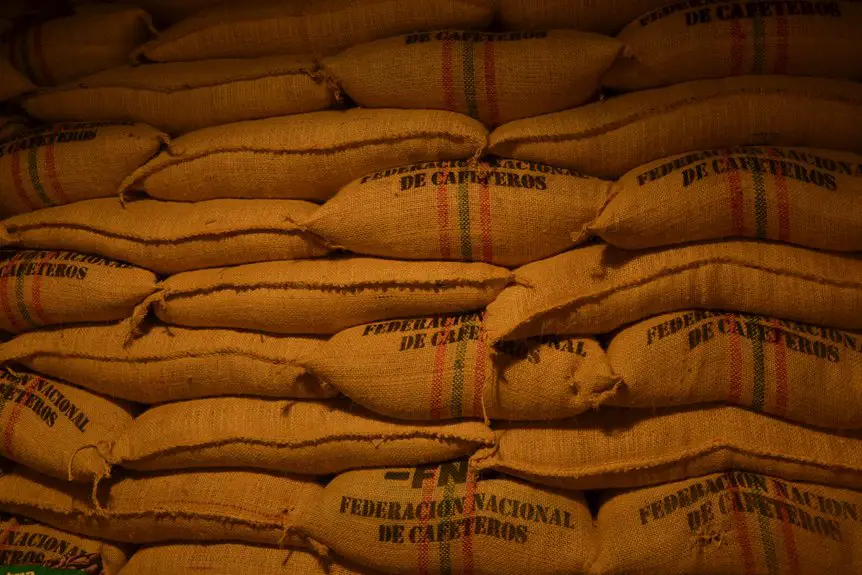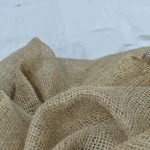You start by growing jute plants in a warm, humid climate, harvesting stalks when they’re golden-brown after 4-6 months. Next, you soak the stalks in water to soften them—a process called retting—then strip the fibers carefully from the woody core. After washing and drying the fibers in the sun, you spin them into yarn, aligning the fibers for strength. Finally, you weave the yarn into durable jute fabric. Keep exploring to understand each step in detail.
Table of Contents
Key Takeaways
- Jute plants are cultivated in warm, humid climates and harvested after 4 to 6 months when stems turn golden-brown.
- Stalks undergo retting by soaking in slow-moving water for 10 to 30 days to loosen fibers.
- Fibers are stripped from the stalks carefully to maintain quality for further processing.
- Washed fibers are thoroughly cleaned and sun-dried, turning periodically to ensure complete drying.
- Dry fibers are spun into yarn and woven into fabric using a crisscross pattern for strength and texture.
Cultivation and Harvesting of Jute Plants
Jute plants thrive in warm, humid climates with plenty of rainfall, making regions like India and Bangladesh ideal for cultivation.
When you grow jute, you’ll plant seeds in well-prepared soil during the early monsoon season. The seeds germinate quickly, and the plants grow tall within a few months. You’ll need to guarantee they get consistent moisture and avoid waterlogging to keep them healthy.
As the plants mature, you’ll notice their golden-brown stems, which indicate they’re ready for harvesting. You’ll typically cut the stalks just above the ground with a sickle, usually after 4 to 6 months of growth.
Harvesting at the right time is essential for quality fiber, so you’ll want to act promptly once the plants reach full maturity.
Retting and Stripping the Jute Fibers
After harvesting, you’ll need to separate the fibers from the stalks through retting, a process that loosens the plant’s outer layers by soaking them in water.
Retting softens the stalks by soaking jute in water, easing fiber separation after harvest.
You submerge the jute bundles in slow-moving water for about 10 to 30 days, depending on climate and water temperature, allowing natural microbial action to break down the pectin binding the fibers.
Once retting softens the stalks, you remove the bundles and begin stripping.
Stripping involves pulling the fibers away from the woody core by hand or with simple tools. You carefully strip the long, golden fibers, ensuring you don’t damage them, as quality depends on intact strands.
This step readies the fibers for washing and drying, setting the foundation for weaving strong, durable jute fabric.
Washing and Drying the Fibers
Once you’ve stripped the fibers, you’ll need to wash them thoroughly to remove any remaining dirt, pectin, and other impurities.
Start by soaking the fibers in clean water, gently agitating them to loosen stubborn residues. Change the water frequently to guarantee effective cleaning.
After washing, squeeze out excess water carefully without damaging the fibers.
Next, spread the fibers evenly under the sun to dry. Drying them completely is vital because moisture can lead to mold growth or weaken the fibers.
Turn them periodically to guarantee even drying on all sides.
Proper washing and drying prepare the fibers for the next stage, ensuring they’re clean, strong, and ready for further processing.
Don’t rush this step, as it directly affects the quality of the final fabric.
Spinning the Fibers Into Yarn
With clean, dry fibers ready, you can start spinning them into yarn. First, you feed the fibers into a spinning machine, which twists and draws them out, transforming loose fibers into a continuous, strong thread.
The spinning process aligns the fibers, increasing their tensile strength and making the yarn uniform in thickness. You’ll notice the machine controls the tension and speed to guarantee consistent yarn quality.
Depending on the final fabric requirements, you might spin the fibers into single or multiple strands, which can later be twisted together for added durability.
Throughout spinning, you keep an eye on fiber alignment and tension to prevent breakage. This step is essential, as well-spun yarn sets the foundation for sturdy, high-quality jute fabric.
Weaving the Yarn Into Jute Fabric
Though spinning creates strong yarn, you still need to weave it into fabric to form the final jute material. Weaving aligns the yarns in a crisscross pattern, which gives the fabric its strength and texture.
You start by setting up the warp threads lengthwise on the loom. Then, the weft threads are woven horizontally through these warp threads.
Here’s how you do it:
- Arrange the warp yarns tightly on the loom.
- Pass the weft yarn across the warp using a shuttle.
- Beat the weft yarn into place with a reed.
- Repeat these steps to build the fabric lengthwise.
This method guarantees the jute fabric is durable, flexible, and ready for further processing.
Frequently Asked Questions
What Are the Environmental Benefits of Using Jute Fabric?
Using jute fabric is like giving nature a gentle hug; you’ll reduce pollution, enjoy a biodegradable product, and support sustainable farming. It’s renewable, needs less water, and helps lower your carbon footprint while staying eco-friendly.
How Durable Is Jute Fabric Compared to Cotton or Polyester?
You’ll find jute fabric less durable than polyester but comparable to cotton. It’s strong for natural fiber, though it wears out faster when exposed to moisture or friction. Use it where breathability and eco-friendliness matter most.
Can Jute Fabric Be Dyed in Different Colors?
Yes, you can dye jute fabric in various colors. It absorbs dyes well, but the colors might appear more muted compared to cotton or polyester. Using natural or reactive dyes works best for vibrant results.
What Are Common Uses of Finished Jute Fabric Products?
Imagine jute fabric as a versatile artist’s canvas—you’ll find it dressed up as eco-friendly bags, rugs, curtains, and upholstery. You’ll also see it guarding seedlings in gardening or wrapped around gifts, blending beauty with purpose.
How Should Jute Fabric Be Cared for and Cleaned?
You should spot clean jute fabric with mild soap and cold water, avoiding soaking. Let it air dry completely, and don’t use harsh chemicals or machine wash, as jute’s natural fibers can weaken and fray easily.
- Where to Buy Sherpa Suede Fabric - July 12, 2025
- How to Draw or Illustrate the Texture of Suede Fabric - July 12, 2025
- What Is Baseball Suede Leather Fabric? - July 12, 2025







